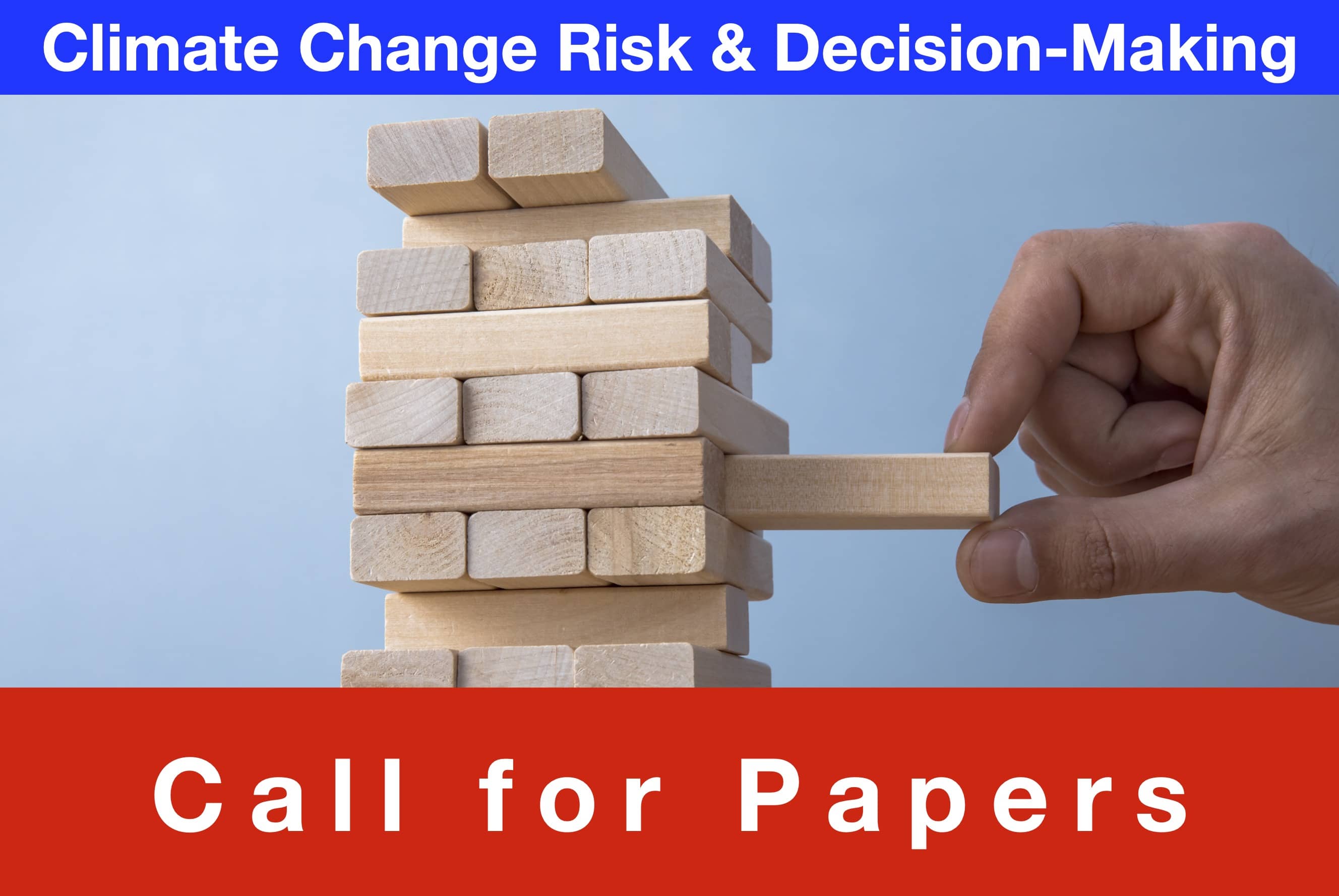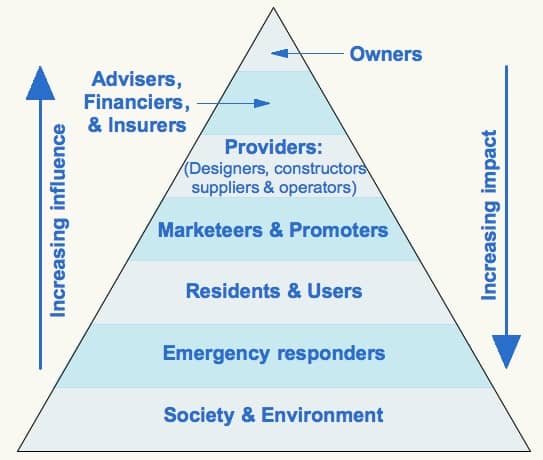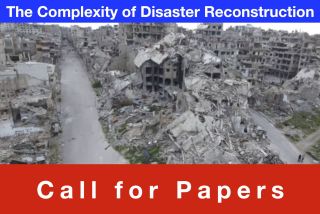
www.buildingsandcities.org/calls-for-papers/climate-change-risk-decision-making.html
Climate Change Risk and Decision-Making

Guest Editors: Simon Foxell and Ian Cooper
Deadline for abstracts: 09 June 2025 (noon GMT)
How should built environment actors (individually and collectively) respond to the increasing risks resulting from the changes to the global and local climates? How can the sector improve its understanding of risk factors and potential responses? What obligations do decision-makers have to act and explain their actions relating to avoidance and mitigation of risk? What processes and shared understandings are needed for identifying, communicating and responding to climate risks? What are the appropriate approaches to thinking about and acting on built environment risk (across a spectrum from 'probability times consequences' to 'how far is safe enough' that locate risk in a larger cultural context?
The Special Issue will examine who owns (or should own) responsibility and accountability for making and recommending decisions about the production and management of the built environment in relation to climate risk. What are the qualities of the risks involved? Who will be impacted by them? And who is responsible/accountable for managing them throughout a building’s/built environment’s life cycle? What are the particular circumstances surrounding the longevity and interdependencies of the built environment and these responsibilities?
The Special Issue will explore the nature of risk assessment, examine case study responses to climate risk to and arising from the built environment at different scales (buildings, places, neighbourhoods, building stocks, cities, infrastructures etc), and address practical, educational and policy responses to that risk.
The aim will be to examine and discuss built environment decision-making in response to perceived climate risk, to propose a consistent language to describe it and to understand and test the validity of communication and decision-making processes that deal with climate risk in the built environment.
Context
Over the past several decades there has been an extensive discussion of climate impacts within the academic, practitioner and regulatory communities. This has led, in particular, to programmes to mitigate or slow down the pace of climate change, through better understanding, education, legislation, international treaties and agreements, practical (and impractical) solutions and the development of a huge body of research - including a substantial proportion relating to the built environment. There have also been attempts to ascertain whether any of this works in practice, although the continuing rise in levels of global carbon emissions suggest only modest levels of hope for a sufficient application of effective solutions (Friedlingstein et al. 2024).
Against the size of mitigation literature and practice there is a more limited output aimed at achieving and testing solutions that adapt the built environment to climate change as a result of past greenhouse gas emissions (UNEP 2022). Similarly, discussions and solutions for avoiding the impacts of climate change through strategic decision-making mainly focus on larger scale propositions such as climate-induced relocation of entire cites or settlements (managed retreat) rather than examine more everyday requirements (Marchman 2022).
In comparison there is even less information on assessing climate risk and practical implementation of responses to that risk; although some matters, often treated as stand-alone concerns, such as extreme weather events, flood risk and overheating have attracted considerable attention. This is potentially a consequence of limited structured discussion and training on risk issues and, as a result, the capacity or ability to assess, analyse and communicate future risk to or from the built environment, whether at a whole system or project level, is largely absent. This Special Issue is aimed at bringing together the work that is being done in this area, as the implications of climate risk become ever more evident.
Recent events; whether directly built environment-related, such as catastrophic structural collapses, fatalities from fires in high rise buildings and the impact of continent-wide heat waves; or pan-societal events such as the Covid pandemic of 2019-22; have made clear the need to envisage and to have adequately prepared for low probability, high impact events. It is preferable to ensure these are avoided altogether, but if not, then, at least, for significant harm reduction measures to have been put in place.
Risk identification
Multiple climate risks, to and from the built environment, have been identified by a wide range of individuals and organisations; including international, state, local, civic society and private bodies. There are readily available models available that provide probabilistic ranges for climate-related outcomes and many analyses emerging from these identify specific potential risks in terms of potential damage and likelihood. This has led not only to generalised concern over issues including the depopulation of cities, stranded assets or curtailment of available resources, but also to specific mapping of potential harms including wildfire, flooding and poor air quality (Alegría 2024). The challenge for the built environment professional sector is to develop an equivalent ability to identify risks resulting from climate change and their accompanying levels of hazard / impact and probability for relevant locations and populations as well as individual projects, and the expertise capable of recommending appropriate responses and actions.
Risks to the wider sector come in many forms (Reisinger 2020), as do potential solutions. Some hazards are one-off and apparently random, even when they can be seen to have a predictable overall frequency of occurrence. Other hazards increase in likelihood or harm level with each occurrence, especially as defences are incrementally weakened or structures deteriorate over time. Especially concerning are systemic hazards linked to other potential harms that may set off chains of events that cause cascading damage.
Given the longevity of built structures and their supporting infrastructures, it seems inevitable that almost all will face a range of climate-caused events, with greater and lesser degrees of threat, at some or more points during their lifecycle. They will largely be expected to survive them, especially as such conditions are already being predicted and should be allowed for. A duty of care also exists to protect the lives and livelihoods of inhabitants (accounting for different exposures and vulnerabilities), especially during adverse conditions. As likelihood ratings and projections covering these potential events are widely available; developers, designers, regulators, insurers and operators (individually and collectively) working in the built environment will need to know how to react and should be able to enact appropriate measures. Not responding to such warnings; without having made appropriate assessments, delivered warnings and recommended relevant actions; may come with severe consequences for those involved.
Responsibilities

Those responsible for making decisions in the built environment sector need to understand and factor in climate risk to their deliberations and proposals, but how should they approach this? In parallel sectors; some within the built environment, for example fire engineering, and in others like health and epidemiology, actuary analysis, investment economics and defence; an extensive set of approaches and systems for identifying, assessing and communicating risk has been developed. This, hardly unexpectedly, is especially true of climate science, which has created and established effective means of understanding and describing different risk profiles and their potential outcomes.
Who is then responsible for addressing climate risk in the built environment? A hierarchy of responsibility will include those who own, and may wish to transfer, the risk or are those responsible for identifying, assessing, managing and reducing it. Undoubtedly those who will bear the brunt of harmful events will be those at the bottom of the pyramid, occupiers and users as well as emergency responders, but others may share some of the financial risk and still others again much of the reputational harm that can occur.
The built environment sector has been grappling with these questions for some time now. What examples already exist of dealing effectively with risk? What lessons have been learnt? What tools, systems and protocols are already available for the sector to expand on or adapt from elsewhere to help it cope meaningfully and responsibly with future climate risk?
Suggested topics must be specific to the built environment and might include:
·
Understanding risk
Making sense and societal
understanding of risk
Sources of information
Risk profiles
Risk interdependencies
Worst case scenarios
Tolerability of risk
Tipping points and irreversible
harms
Navigating risk
Future trends
·
Risk ownership and
responsibilities
Hierarchies and models of
ownership
Risk transfer
Legal frameworks
Stranded assets
Managed retreat
·
Risk ethics
Risk, morality and equity
Duties to and involvement of society
and individuals
Professional and organisational ethics
Balancing responsibilities
·
Modelling risk and risk outcomes
Assessment models (for building
stocks & project stages: planning, design, construction, occupation, etc)
Economic models for risk /
alternative approaches accounting for inequity and fairness
Choice and deployment of evidence
Framing and boundary setting
Metrics for assessing and
quantifying climate risk
·
Risk management
Risk avoidance
Climate adaptation
Resilience
Regulation
Behaviour change
Balancing options
Timescales
Emergency planning
·
Decision-making
Scales of actions and agreements
(international, national, regional, local, site-specific)
Policy-making
Decision-making processes and
tools
Prioritization protocols
Forward programmes
·
Information management and
communication
Communicating and reporting risk
and risk factors – to supply chain and to civil society
Guidance and advice
Whistleblowing
Proposed timeline
|
Deadline for abstract submission |
09 June 2025 noon GMT |
NB: authors can submit sooner if they wish |
|
Full papers due |
22 September 2025 |
|
|
Referees’ & editors’ comments to authors |
15 January 2026 |
|
|
Final version of papers |
16 February 2026 |
|
|
Publication of special issue |
April 2026 |
NB: papers are published as soon as accepted |
Briefing note for contributors
We welcome contributions from the research community in both the Global North and Global South.
You are invited to submit an abstract for this special issue. Please send a 500 word (maximum) abstract to editor Richard Lorch by 09 June 2025 (noon GMT).
Your
submission must include these 3 items in one DOCX file:
1.
the author's and
all co-author's names, institutional & departmental affiliations and
contact details, email addresses and ORCID numbers
2.
the question(s)
or topic(s) in this Call for Papers that the abstract and intended paper
address
3.
the abstract (500
words maximum) defining the research question(s), scope, methods and results
Abstracts will be reviewed by the editors to ensure a varied, yet integrated selection of papers around the topic. Authors of accepted abstracts will be invited to submit a full paper (6000-8000 words), which undergoes a double-blind review process.
Buildings & Cities is an international, open access, double-blind peer-reviewed research journal. Its focus is the interactions between buildings, neighbourhoods and cities by understanding their supporting social, economic and environmental systems. More information can be found online: https://www.buildingsandcities.org/ & published papers are found here: https://journal-buildingscities.org/
General guidance for authors can be found at https://www.buildingsandcities.org/pdf/Information-for-Authors.pdf
Open access and Article Processing Charge
Buildings & Cities is an open access journal and has an article processing charge (APC) of £1360 plus VAT. If you do not have institutional support, please contact the editor when submitting your abstract. We endeavour to assist those without funding.
Questions?
The Editors are happy to discuss ideas with potential authors. Please contact: Richard Lorch , Simon Foxell and Ian Cooper
References
Alegría, A., Poloczanska, E., Loeschke, S. et al. (2024). Towards an IPCC Atlas for comprehensive climate change risk assessments. NPJ Climate Action 3, 108. https://doi.org/10.1038/s44168-024-00193-3
Friedlingstein, P. et al. (2025) Global Carbon Budget 2024. Earth Systems Science Data, 17, 965–1039. https://doi.org/10.5194/essd-17-965-2025
Marchman, P.M. (2022). Climate-Induced Relocation. In: Brears, R.C. (eds) The Palgrave Encyclopedia of Urban and Regional Futures. Cham: Palgrave Macmillan. https://doi.org/10.1007/978-3-030-87745-3_108
Reisinger, Andy, Howden, M., Vera, C. et al. (2020). The Concept of Risk in the IPCC Sixth Assessment Report: A Summary of Cross-Working Group Discussions. Geneva: Intergovernmental Panel on Climate Change. https://www.ipcc.ch/site/assets/uploads/2021/02/Risk-guidance-FINAL_15Feb2021.pdf
UNEP. (2022). Adaptation Gap Report 2022: Too Little, Too Slow – Climate adaptation failure puts world at risk. Nairobi: United Nations Environment Programme. https://www.unep.org/adaptation-gap-report-2022
Latest Peer-Reviewed Journal Content
Acceptability of sufficiency consumption policies by Finnish households
E Nuorivaara & S Ahvenharju
Key factors for revitalising heritage buildings through adaptive reuse
É Savoie, J P Sapinski & A-M Laroche
Cooler streets for a cycleable city: assessing policy alignment
C Tang & J Bush
Understanding the embodied carbon credentials of modern methods of construction
R O'Hegarty, A McCarthy, J O'Hagan, T Thanapornpakornsin, S Raffoul & O Kinnane
The changing typology of urban apartment buildings in Aurinkolahti
S Meriläinen & A Tervo
Embodied climate impacts in urban development: a neighbourhood case study
S Sjökvist, N Francart, M Balouktsi & H Birgisdottir
Environmental effects of urban wind energy harvesting: a review
I Tsionas, M laguno-Munitxa & A Stephan
Office environment and employee differences by company health management certification
S Arata, M Sugiuchi, T Ikaga, Y Shiraishi, T Hayashi, S Ando & S Kawakubo
Spatiotemporal evaluation of embodied carbon in urban residential development
I Talvitie, A Amiri & S Junnila
Energy sufficiency in buildings and cities: current research, future directions [editorial]
M Sahakian, T Fawcett & S Darby
Sufficiency, consumption patterns and limits: a survey of French households
J Bouillet & C Grandclément
Health inequalities and indoor environments: research challenges and priorities [editorial]
M Ucci & A Mavrogianni
Operationalising energy sufficiency for low-carbon built environments in urbanising India
A B Lall & G Sethi
Promoting practices of sufficiency: reprogramming resource-intensive material arrangements
T H Christensen, L K Aagaard, A K Juvik, C Samson & K Gram-Hanssen
Culture change in the UK construction industry: an anthropological perspective
I Tellam
Are people willing to share living space? Household preferences in Finland
E Ruokamo, E Kylkilahti, M Lettenmeier & A Toppinen
Towards urban LCA: examining densification alternatives for a residential neighbourhood
M Moisio, E Salmio, T Kaasalainen, S Huuhka, A Räsänen, J Lahdensivu, M Leppänen & P Kuula
A population-level framework to estimate unequal exposure to indoor heat and air pollution
R Cole, C H Simpson, L Ferguson, P Symonds, J Taylor, C Heaviside, P Murage, H L Macintyre, S Hajat, A Mavrogianni & M Davies
Finnish glazed balconies: residents' experience, wellbeing and use
L Jegard, R Castaño-Rosa, S Kilpeläinen & S Pelsmakers
Modelling Nigerian residential dwellings: bottom-up approach and scenario analysis
C C Nwagwu, S Akin & E G Hertwich
Mapping municipal land policies: applications of flexible zoning for densification
V Götze, J-D Gerber & M Jehling
Energy sufficiency and recognition justice: a study of household consumption
A Guilbert
Linking housing, socio-demographic, environmental and mental health data at scale
P Symonds, C H Simpson, G Petrou, L Ferguson, A Mavrogianni & M Davies
Measuring health inequities due to housing characteristics
K Govertsen & M Kane
Provide or prevent? Exploring sufficiency imaginaries within Danish systems of provision
L K Aagaard & T H Christensen
Imagining sufficiency through collective changes as satisfiers
O Moynat & M Sahakian
US urban land-use reform: a strategy for energy sufficiency
Z M Subin, J Lombardi, R Muralidharan, J Korn, J Malik, T Pullen, M Wei & T Hong
Mapping supply chains for energy retrofit
F Wade & Y Han
Operationalising building-related energy sufficiency measures in SMEs
I Fouiteh, J D Cabrera Santelices, A Susini & M K Patel
Promoting neighbourhood sharing: infrastructures of convenience and community
A Huber, H Heinrichs & M Jaeger-Erben
New insights into thermal comfort sufficiency in dwellings
G van Moeseke, D de Grave, A Anciaux, J Sobczak & G Wallenborn
'Rightsize': a housing design game for spatial and energy sufficiency
P Graham, P Nourian, E Warwick & M Gath-Morad
Implementing housing policies for a sufficient lifestyle
M Bagheri, L Roth, L Siebke, C Rohde & H-J Linke
The jobs of climate adaptation
T Denham, L Rickards & O Ajulo
Structural barriers to sufficiency: the contribution of research on elites
M Koch, K Emilsson, J Lee & H Johansson
Disrupting the imaginaries of urban action to deliver just adaptation [editorial]
V Castán-Broto, M Olazabal & G Ziervogel
Nature for resilience reconfigured: global- to-local translation of frames in Africa
K Rochell, H Bulkeley & H Runhaar
How hegemonic discourses of sustainability influence urban climate action
V Castán Broto, L Westman & P Huang
Fabric first: is it still the right approach?
N Eyre, T Fawcett, M Topouzi, G Killip, T Oreszczyn, K Jenkinson & J Rosenow
Social value of the built environment [editorial]
F Samuel & K Watson
Understanding demolition [editorial]
S Huuhka
Data politics in the built environment [editorial]
A Karvonen & T Hargreaves


Latest Commentaries
Decolonising Cities: The Role of Street Naming
During colonialisation, street names were drawn from historical and societal contexts of the colonisers. Street nomenclature deployed by colonial administrators has a role in legitimising historical narratives and decentring local languages, cultures and heritage. Buyana Kareem examines street renaming as an important element of decolonisation.
Integrating Nature into Cities
Increasing vegetation and green and blue spaces in cities can support both climate change mitigation and adaptation goals, while also enhancing biodiversity and ecological health. Maibritt Pedersen Zari (Auckland University of Technology) explains why nature-based solutions (NbS) must be a vital part of urban planning and design.